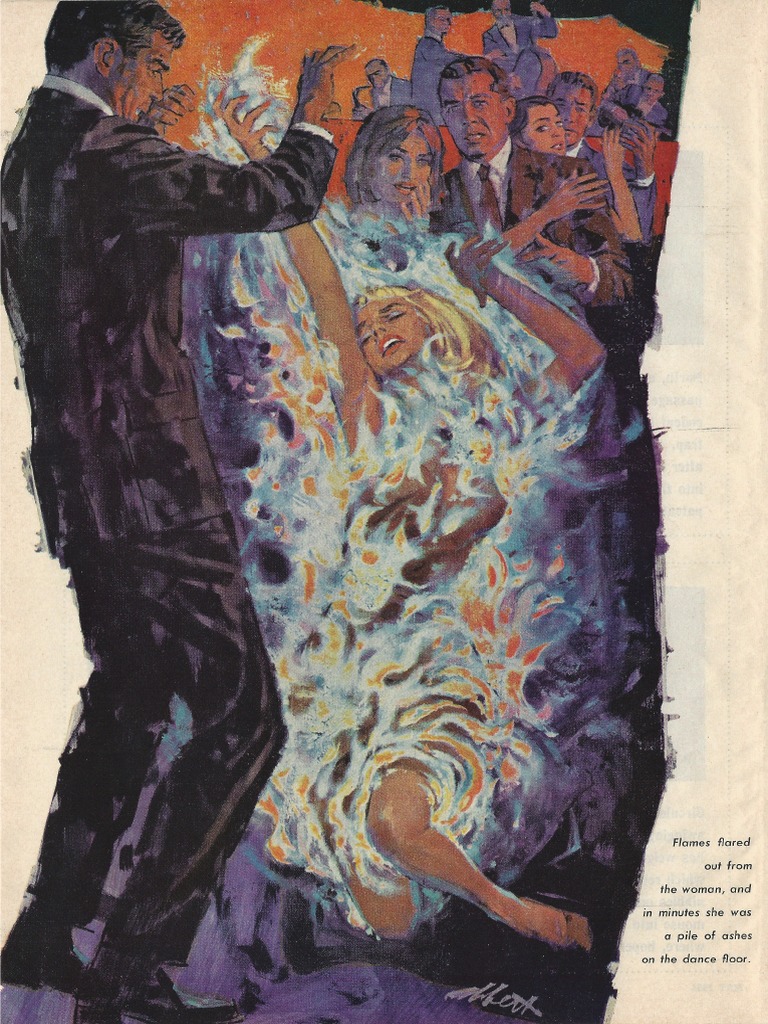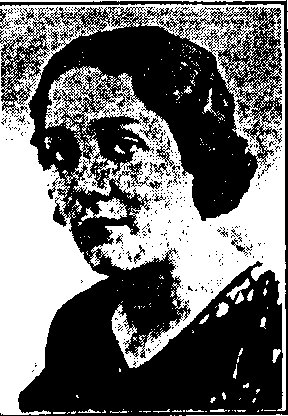1938, August 27: Phyllis Newcombe’s Combustion
The Legend:
On August 27, 1938, 22-year-old Phyllis Newcombe was dancing with her fiancé Henry McAusland at the weekly dance in the Shire Hall of Chelmsford, Essex, when suddenly "bluish flames" enveloped her.

The blue flames destroyed her... [Larger version here]
As her dance partner and the other dancers watched in horror, Newcombe crumpled to the floor. The blue flames seemed to be emanating from her own body, and efforts made to extinguish them failed... and within minutes, Phyllis Newcombe had been reduced to "a blackened mass of ash," which was "unrecognizable as a human being." This horrifying event is one of just a rare few fully witnessed occurrences of that deadly phenomena, Spontaneous Human Combustion!
Just one small problem, though... almost all of the facts are wrong.
The Real Story
The above legend was laboriously researched by Jan Willem Nienhuys in 2001, and I will now summarize what he discovered. [Nienhuys' excellent study is available online at his website at Skepsis website. He includes reprints of the main newspaper articles involved.]
On August 27, 1938, 22-year-old Phyllis Newcombe had in fact gone dancing with her fiance, henry McAusland, and had a good night out. The real trouble started when they were leaving the dance; as the two approached a stairway just outside of the dance hall, Newcombe's dress caught on fire, starting with the hemline on the floor in front of her. The flames spread upwards rapidly, and she turned and ran back into the dance hall. As she collapsed just inside the hall, covered in flames by this time, several of the men at the dance threw their coats over her and smothered the flames. An ambulance was called but, due to the towns' lack of resources, the ambulance took over twenty minutes to arrive before rushing Newcombe to the hospital.

Phyllis Newcombe. [Picture sources here]
Newcombe was severely burned on her legs and body, yet was considered to be in "fairly satisfactory" condition on September 2 and was aware and chatting with her family and fiance. Despite this, she died on September 15 due to an infection in her wounds spreading through her body. An inquest was immediately called for.
At the inquest, Newcombe's fiance, McAusland, forwarded his opinion that her dress may have been lit by a cigarette butt that had come in contact with it. To test this, Newcombe's father brought in a piece of the material used to make the dress. The coroner, Mr. L.F. Beccles, then demonstrated that the material would immediately flare up if exposed to an open flame, but would not light up if exposed to a lit cigarette.
McAusland also volunteered that Newcombe's dress had been cleaned six weeks before the dance, and suggested that maybe a chemical agent had assisted its combustion. Unable to narrow down the exact cause, Beccles rendered a verdict of 'Accidental Death,' and recorded that the clothing had caught fire from some reason unknown.
The Continuing Story of Phyllis Newcombe
Over the next two decades, Newcombe's death was reported sparingly in publications devoted to stories of unsolved mysteries and paranormal events, generally as an example of an unexplained fire death... but was not yet considered to be a case of spontaneous human combustion. In these brief one-line reports, Newcombe's name was often left out and the description of where the event took place changed from "a dance hall" to "in the middle of a dance hall."
In 1957, Eric Frank Russell's book Great World Mysteries re-told the story in greater detail, all incorrect. In his version, Newcombe (who is never named) was dancing in the middle of the hall with other couples when she burst into flames and burned "like a blow-torch" until dead. This story was further expanded on by Allan Eckert in an article he wrote for True magazine in May 1964 (whose article supplied the spectacularly incorrect illustration above), and by Vincent Gaddis in his book Mysterious Fires and Lights, published in 1967. The story that emerged from these authors was that of a young lady who burst into blue flames in the middle of a dance floor in Chelmsford, England. No one could extinguish these flames, and she was reduced to a mass of ashes within minutes... and she was still unnamed. From this anonymous account, an all-new -- and entirely fictitious -- account of a girl named Maybelle Andrew was later created; for more on that account, follow the 'See Also' link below.
Phyllis Newcombe's name was finally attached to the new legend of her death in 1976 by Michael Harrison in his book, Fire From Heaven. It's clear from the text that Harrison had seen some of the earlier accounts of Newcombe's death, and had then attached her to the legend he'd picked up either from Eckert's or Gaddis' work... it's unclear if he ever knew that the two different accounts were actually related, or if he was just trying to add some facts to an unproven legend to make it sound more authoritative. In Harrison's version of the story, Newcombe bursts into flames while dancing, and dies minutes later in the manager's office of severe burns.
The final transmutation of Newcombe's death came in Larry Arnold's 1995 book, Ablaze!, where, again, she is dancing with her fiance McAusland, when she bursts into flames; but this time, despite McAusland trying to beat out the flames bare handed, "in minutes she was ashes, unrecognizable as a human being..." but distinctly recognizable as a case of spontaneous human combustion. It is this version of the tale that is most often repeated, for the obvious reason that it is both exciting and supernatural; but inconveniently, just not true.
Theories
One mystery still remains, however; how did Newcombe's dress actually catch on fire that night in Chelmsford? One plausible answer that was suggested by Nienhuys in his study was that a lit match had fallen on the front of her dress, tossed by some "careless person," as Henry McAusland had suggested. Which careless person?
Likely, Henry McAusland himself.
McAusland testified that he had been walking about five steps in front of Newcombe that night when her dress caught fire. He was also the person who suggested that a careless cigarette might have caused the accident. So the main question that will probably never have an answer is whether or not McAusland had lit a cigarette and dropped a match that fateful night.
Anomalies -- the Strange & Unexplained, as well as my other website -- Monsters Here & There -- are supported by patrons, people like you! All new Anomalies articles are now posted for my patrons only, along with exclusive content made just for them. You can become a patron for just $1 a month!
|








